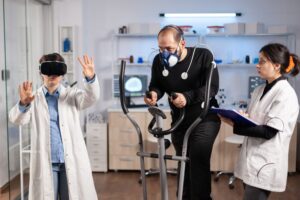Unleashing Human Capability: Revolutionary Approaches Unveiled in Modern Occupational Therapy
Occupational therapy, a profession driven by compassion and expertise, plays a vital role in enhancing individuals’ lives and helping them regain independence. It is an allied health discipline that focuses on empowering individuals to participate in meaningful activities despite physical, cognitive, or emotional challenges they may face.
With its roots dating back to the early 20th century, occupational therapy has evolved significantly over time, embracing innovative techniques that unlock the true potential of its recipients.
Definition and Importance of Occupational Therapy
Occupational therapy is a client-centred healthcare profession aimed at promoting health, well-being, and functional independence through engagement in purposeful activities. The primary goal is to enable individuals to participate actively in their daily lives and achieve their fullest potential despite limitations or disabilities.
This holistic approach considers the physical, psychological, social, and environmental factors influencing an individual’s ability to engage in occupations (activities) that are meaningful to them.
Whether it’s a child with developmental delays struggling with self-care skills or an elderly person recovering from a stroke adapting to daily routines, occupational therapists address both the physical impairments and psychosocial barriers hindering participation. The importance of occupational therapy cannot be overstated.
It enables individuals to regain lost skills or adapt to new ones following injuries or illnesses. By focusing on improving function and facilitating independence in various areas of life—such as self-care tasks, work-related activities, and leisure pursuits—occupational therapists empower their clients to lead fulfilling lives.
Unlocking Potential through Innovative Techniques
In recent years, there has been a surge of innovative techniques within the field of occupational therapy that aim not only to restore lost abilities but also uncover untapped potential among those receiving therapeutic interventions.
These groundbreaking approaches have revolutionized traditional practices by harnessing technology, incorporating mindfulness-based interventions, and leveraging the power of sensory integration. This article will delve into these innovative techniques and their transformative impact on unlocking potential in occupational therapy.
We will explore the principles behind sensory integration therapy, the application of assistive technologies to enhance independence, the immersive experiences offered by virtual reality applications, and the implementation of mindfulness-based interventions for holistic well-being.
Through a comprehensive examination of these techniques, we aim to inspire both practitioners and clients alike to embrace new possibilities and unlock their true potential.

The Evolution of Occupational Therapy
From Ancient Times to Modern Practice: Tracing the Historical Background and Origins of Occupational Therapy
Occupational therapy may seem like a contemporary profession, but its roots can be traced back to ancient times.
The concept of occupation as a therapeutic tool can be found in various civilizations, such as the Egyptians, Greeks, and Romans.
However, it was during the late 18th and early 19th centuries that occupational therapy started to take shape as a formal discipline. In the late 1700s, Philippe Pinel introduced moral treatment practices in mental health institutions that emphasized engagement in purposeful activities for patients’ well-being.
It was during this time that the notion of using occupations for physical and mental health rehabilitation gained recognition. The true birth of occupational therapy as we know it today can be attributed to two influential figures: William Rush Dunton Jr. and Eleanor Clarke Slagle.
Dunton is often referred to as the “Father of Occupational Therapy” due to his significant contributions in establishing occupational therapy education and practice standards. He authored numerous books on the subject and played a crucial role in shaping occupational therapy’s professional identity.
The Shift from Traditional Approaches to Modern Innovations in Occupational Therapy
Throughout history, occupational therapy has undergone significant shifts in its approaches and philosophies. Initially, the focus was primarily on providing structured activities aimed at restoring function or maintaining physical health.
However, with advancements in medical knowledge and psychological research, there has been a paradigm shift towards a holistic approach.
In recent decades, modern occupational therapy has embraced an integrated model that recognizes the interplay between physical, cognitive, emotional, and social factors influencing human occupation. This shift acknowledges individuality rather than focusing solely on deficits or impairments.
Moreover, occupational therapists have increasingly incorporated evidence-based practices into their interventions—a direct response to demands for accountability within healthcare systems. The integration of research evidence with clinical expertise has fueled the development of innovative techniques that aim to unlock potential and maximize clients’ functional outcomes.
Occupational therapy’s evolution continues to be shaped by ongoing research, advancements in technology, and a growing understanding of the complexities of human occupation. In the subsequent sections, we will delve into some of the innovative techniques used by modern occupational therapists to unlock potential and facilitate transformative outcomes for their clients.
Understanding Potential in Occupational Therapy
Defining Potential in the Context of Occupational Therapy
In the realm of occupational therapy, potential refers to an individual’s capacity to engage in meaningful activities and achieve a desirable level of functionality. It encompasses the ability to carry out daily tasks, participate in social interactions, and pursue personal goals.
However, it is crucial to recognize that potential is not a fixed entity but rather a dynamic concept that can be cultivated and expanded through therapeutic interventions. Occupational therapists view potential as the untapped abilities and strengths that lie within each person, waiting to be discovered and harnessed for optimal well-being.
Factors Influencing Potential: Physical, Cognitive, Emotional, and Environmental Aspects
The potential of an individual is influenced by various factors that encompass physical capabilities, cognitive functioning, emotional well-being, and environmental circumstances. Physical aspects include motor skills, strength, endurance, balance, coordination, range of motion, and sensory processing abilities.
Cognitive factors involve cognitive skills such as attention span, memory, and problem-solving abilities, as well as executive functions like planning and decision-making. Emotional aspects encompass one’s emotional regulation skills and resilience when facing challenges or stressors.
Environmental factors play a significant role in shaping potential by considering elements such as social support networks, cultural influences, accessible physical environments (e.g., home modifications), socioeconomic status (SES), and access to healthcare services and resources.
These multiple dimensions interconnect synergistically in determining an individual’s potential within an occupational therapy framework. Recognizing this holistic approach allows occupational therapists to develop comprehensive treatment plans tailored to address specific needs while harnessing the unique strengths of each individual they work with.

Sensory Integration Therapy: Enhancing Occupational Potential through Sensory Engagement
Sensory integration therapy is a cornerstone technique in modern occupational therapy that focuses on how the brain processes and responds to sensory information. By understanding and applying sensory integration theory, occupational therapists can unlock the potential of individuals with sensory processing difficulties.
This approach involves creating controlled sensory experiences to help individuals regulate their responses, develop appropriate adaptive behaviours, and improve overall function. Various techniques are utilized, such as the brushing protocol, which involves using specific brushes to provide deep-pressure touch stimulation to the skin, helping individuals better organize their senses.
Additionally, weighted vests can be used to provide deep proprioceptive input, promoting a sense of body awareness and a calming effect. Case studies have demonstrated remarkable outcomes through sensory integration therapy, revealing increased attention span, improved social interactions, and enhanced overall participation in daily activities.
Assistive Technology: Empowering Independence and Unleashing Potential
In today’s digital age, assistive technology has revolutionized occupational therapy practice by unlocking the potential of individuals with disabilities or limitations. These devices range from adaptive equipment tailored to specific needs to computer-based tools that enhance functional capabilities.
By providing customized solutions based on individual requirements, assistive technology enables users to perform daily tasks independently and efficiently. For instance, adaptive equipment like modified utensils or wheelchair modifications enables individuals with physical disabilities to engage in self-care activities or mobility with greater ease.
Computer-based tools offer alternative access methods for those with limited motor skills or communication impairments, effectively bridging gaps in functional abilities. The utilization of assistive technology not only enhances independence but also fosters confidence and unleashes untapped potential.
Virtual Reality (VR) Applications: Transforming Rehabilitation Possibilities
Virtual reality (VR) has emerged as an innovative tool within occupational therapy for rehabilitation purposes. By simulating real-life scenarios within a controlled virtual environment, VR can significantly improve functional skills and unlock potential across various populations.
VR applications allow individuals to practice activities of daily living or engage in vocational simulations, enabling them to regain skills and confidence with reduced risk. For example, a stroke survivor can engage in virtual gardening tasks to rebuild fine motor skills and cognitive processing related to planning and problem-solving.
With VR, therapists can adjust the complexity of the tasks, tailor interventions to individual needs, and provide immediate feedback. This immersive technology unlocks new possibilities for rehabilitation while instilling hope for individuals on their journey toward regaining independence.
Holistic Approaches to Unlocking Potential: The Power of Mindfulness
Mindfulness-based interventions have gained recognition within occupational therapy practice as powerful tools for unlocking potential by enhancing self-awareness, attention, and overall well-being.
By cultivating present-moment awareness without judgment, individuals can develop resilience and effectively manage stressors that may hinder their occupational engagement. Mindfulness techniques such as focused breathing exercises or body scans allow individuals to connect with their body’s sensations and emotions.
These practices enhance the self-regulation skills necessary for engaging in meaningful activities and overcoming barriers that limit potential. Moreover, integrating mindfulness into therapy sessions promotes client-centred care by fostering a therapeutic relationship rooted in trust, acceptance, and empathy.
Conclusion
Innovative techniques within modern occupational therapy are transforming the way we unlock potential in individuals across various populations. Sensory integration therapy provides a foundation for understanding how sensory experiences impact function while offering practical strategies tailored to meet individual needs.
Assistive technology empowers independence by providing customized solutions that bridge functional gaps and enhance engagement in daily activities. Virtual reality applications revolutionize rehabilitation possibilities through realistic simulations that enable individuals to regain skills with reduced risk.
Holistic approaches like mindfulness-based interventions foster self-awareness, attentional focus, and overall well-being as key components of unleashing untapped potential. By embracing these innovative techniques, occupational therapists have the power to unlock potential and enable individuals to lead fulfilling, independent lives.










